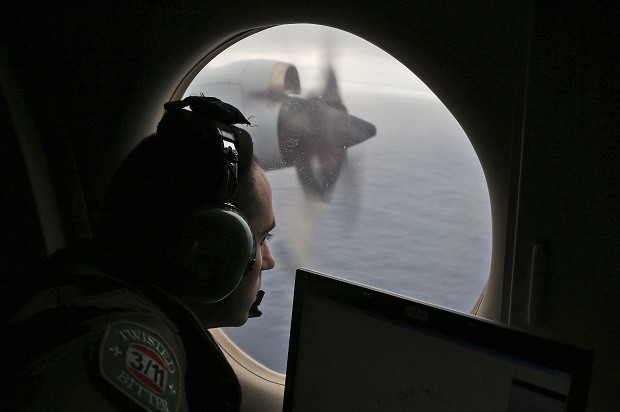
In this March 22, 2014 file photo, flight officer Rayan Gharazeddine on board a Royal Australian Air Force AP-3C Orion, searches for the missing Malaysia Airlines Flight MH370 in southern Indian Ocean, Australia. The oceanographer who led American adventurer Blaine Gibson to Madagascar where he found a potential debris field from the missing Malaysia Airlines jet says drift modeling suggests that Flight 370 could have crashed north of the current search area. The comments comes after Gibson on Tuesday, July 19, 2016, handed Malaysian authorities in Kuala Lumpur pieces of debris and personal belongings found on Madagascar beaches in June, which he suspects came from the jet that vanished with 239 people on board in 2014. AP FILE PHOTO
CANBERRA, Australia — The oceanographer whose calculations helped an American adventurer find potential debris from Flight 370 said Thursday that the Malaysia Airlines jetliner could have crashed slightly north of the current search area.
Adventurer Blaine Gibson handed Malaysian authorities in Kuala Lumpur on Tuesday three pieces of debris and personal belongings that he found on Madagascar beaches in June, which he suspects came from the Boeing 777 that vanished with 239 people on board during a flight from Kuala Lumpur to Beijing on March 8, 2014.
Another six pieces of potential debris found by Gibson are waiting with Madagascar authorities for Malaysia to collect.
READ: Debris in Mozambique, Mauritius to be analyzed by MH370 team
Western Australia University oceanographer Charitha Pattiaratchi said he had told Gibson that Flight 370 debris was likely to concentrate on Madagascar. Pattiaratchi’s earlier advice had led Gibson to Mozambique where he found debris in February that experts later determined came from Flight 370.
“He rang me from the Maldives and said: ‘Where should I go? Should I go to Rodrigues, Mauritius, Reunion, Madagascar, Mozambique, South Africa?'” Pattiaratchi said Thursday. “I said: ‘Your best bet is the northeast part of Madagascar,’ which is where he went.”
Pattiaratchi said the same modeling led his team of oceanographers to suspect that the airliner could have gone down just north of the search area in the southern Indian Ocean.
“The best guess that we think is that it’s probably around the Broken Ridge region, which is slightly to the north of the area that they’re looking at,” Pattiaratchi said.
But he could not eliminate the possibility that the aircraft had indeed crashed within the 120,000 square kilometers (46,000 square miles) of seabed currently being searched southwest of Australia.
Despite the drift modeling and other predictions officials have made about the plane’s possible flight path, no one knows what happened to the aircraft or precisely where it crashed in what has become one of aviation’s biggest mysteries.
Officials from Malaysia, China and Australia will meet in Kuala Lumpur on Friday to discuss the future of the underwater search, with fewer than 10,000 square kilometers (3,900 square miles) remaining to be scanned by ships towing sonar equipment. The search of the seabed has not yielded a single clue.
Pattiaratchi’s modeling was based on how long the first piece of confirmed Flight 370 wreckage took to reach La Reunion island off the African coast a year ago.
Another four pieces found along shorelines in the southwestern Indian Ocean have since been determined as almost certainly from Flight 370.
Gibson gives credit to Pattiaratchi and Australian government oceanographer David Griffin for his finds, although only one has been confirmed as part of Flight 370. Griffin’s advice led Gibson to a second Madagascar island where he found the potential debris that he brought to Malaysia.
Gibson said he had been told by Malaysian officials that costs were the reason that a Malaysian investigator had twice canceled plans to fly to Madagascar to retrieve debris he had found.
“They tell me it’s a budgetary situation,” he said. “If you’re spending hundreds of millions of dollars to search under water and finding nothing, and it’s only a plane ticket to pick up six pieces and some personal effects, you ought to just do it.”
READ: Search for MH370 likely to end by August